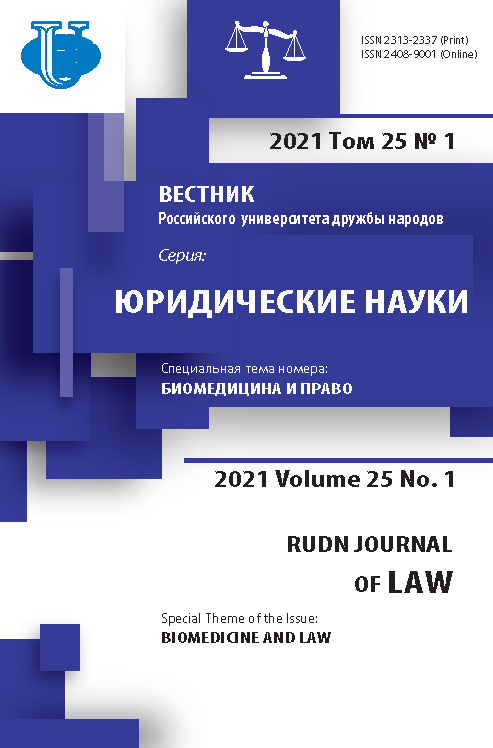Legal regulation in the field of genetically modified organisms (GMO) turnover in Russia and foreign countries
- Authors: Novikova R.G.1,2
-
Affiliations:
- Kutafin Moscow State Law University (MSAL)
- Peoples' Friendship University of Russia (RUDN University)
- Issue: Vol 25, No 1 (2021): BIOMEDICINE AND LAW
- Pages: 32-66
- Section: GENETICS AND LAW
- URL: https://journals.rudn.ru/law/article/view/26035
- DOI: https://doi.org/10.22363/2313-2337-2021-25-1-32-66
- ID: 26035
Cite item
Full Text
Abstract
One of the most relevant issues, which today’s society face is the use of advanced technologies in the field of GMO and GM-food. Taking a look at the world map of law we can see diverse legal regulation of GMO turnover, especially in the context of regulation and control of genomic studies and their practical application, risk assessment of uncontrollable GMO spreading and technologies of genetic editing of organisms including at the level of research planning. The comparative legal analysis of foreign regulation (including in dominant jurisdictions), provided in this article allows revealing those distinctions, determining the basic tendencies in GMO legal development and connected products with GMO components, including the matters of control with regard to GMO turnover. The analysis allowed drawing several recommendations on borrowing foreign experience for the sake of revising Russian regulation, i.e., taking regulatory measures to develop the relevant sphere of social relationships - legal acts, governmental decrees, etc. oriented towards the development of biotechnologies, raising confidence of citizens in genetics, stimulation of GMO production efficiency, and innovative development. Russia is a member of the Eurasian Economic Union (EAEU); therefore, the article discusses the national laws of these countries concerning GMO and contains recommendations for harmonizing the legal framework of the supranational level in the field of GMO turnover.
About the authors
Ramilya G. Novikova
Kutafin Moscow State Law University (MSAL); Peoples' Friendship University of Russia (RUDN University)
Author for correspondence.
Email: ramiletta@gmail.com
SPIN-code: 8764-5169
Сandidate of Legal Sciences, Associate Professor, Law Institute, Peoples' Friendship University of Russia (RUDN University); Senior Researcher, Scientific Center for Law and Bioethics in the Field of Genomic Research and Application of Genetic Technologies, Kutafin Moscow State Law University (MSAL)
9 Sadovaya - Kudrinskaya str., Moscow, 123995, Russian Federation; 6 Miklukho-Maklaya str., Moscow, 117198, Russian FederationReferences
- Al-Harbi, A., Lary, S., Edwards, M. G., Qusti, S., Cockburn, A., Poulsen, M. & Gatehouse, A. (2019) A proteomic-based approach to study underlying molecular responses of the small intestine of Wistar rats to genetically modified corn (MON810). Transgenic research. 28(5-6), 479-498. https://doi.org/10.1007/s11248-019-00157-y.
- Carman, J., Vlieger, H., Ver Steeg, L., Sneller, V., Robinson, G., Clinch-Jones, C., Haynes, J. & Edwards, J. (2013) A long-term toxicology study on pigs fed a combined genetically modified (GM) soy and GM maize diet. Journal of Organic Systems. 8(1), 38-54.
- Davison, J. & Bertheau, Y. (2008) The Theory and Practice of European Traceability Regulations for GM Food and Feed. Cereal Foods World. 53(4), 186-196.
- Deykin, A.V., Kuznecova, V.N., Kirikovich, Yu.K., Kovalenko, D.V. & Soldatov, V.O. (2019) GMO Restriction: Belarus, BRICS, EU, USA. Azimuth of Scientific Research: Economics and Administration. 8(4(29)). 141-145. (in Russian).
- Gao, M., Li, B., Yuan, W., Zhao, L. & Zhang, X. (2014) Hypothetical link between infertility and genetically modified food. Recent Patents on Food, Nutrition & Agriculture. 6(1), 16-22.
- Giraldo, P.A., Shinozuka, H., Spangenberg, G.C., Cogan, N., & Smith, K.F. (2019) Safety Assessment of Genetically Modified Feed: Is There Any Difference From Food? Frontiers in plant science. 10(1592). doi: 10.3389/fpls.2019.01592
- Evans, B. R., Kotsakiozi, P., Costa-da-Silva, A. L. & Ioshino, R. S. et. al. (2020) Editorial Expression of Concern: Transgenic Aedes aegypti Mosquitoes Transfer Genes into a Natural Population. Scientific reports. 10(1), 5524. doi: 10.1038/s41598-020-62398-w
- Kiliç, A. & Akay, M.T. (2008) A three generation study with genetically modified Bt corn in rats: Biochemical and istopathological investigation. Food Chem Toxicol. 46(3), 1164-1170. doi: 10.1016/j.fct.2007.11.016
- Lu, Y., Wu, K., Jiang, Y., Guo, Y. & Desneux, N. (2012) Widespread adoption of Bt cotton and insecticide decrease promotes biocontrol services. Nature. 487(7407), 362-365. Doi.org/10.1038/nature11153
- Makarova, S.S., Khromov, A.V., Spechenkova, N.A., Talyansky, M.E. & Kalinina, N.O. (2019) Using the CRISPR/Cas system to create pathogen-resistant plants. Overview. Biochemistry. 84(1), 24-37. doi: 10.1134/S0320972519010020 (in Russian).
- Miroshnichenko, D.N., Shulga, O.A., Timerbaev, V.R. & Dolgov, S.V. (2019) Generation of Nontransgenic Genome-edited Plants: Achievements, Challenges and Prospects. Biotekhnologiya. Vol. 35(1), 3-26. doi: 10.21519/0234-2758-2019-35-1-3-26
- Oliver, M.J. (2014) Why we need GMO crops in agriculture. Missouri Medicine. 111(6), 492-507.
- Tudisco, R., et al. (2015) Genetically modified soybean in a goat diet: Influence on kid performance. Small Ruminant Research. 126(1), 67-74.
- Plavec, T.V. & Berlec, A. (2020) Safety Aspects of Genetically Modified Lactic Acid Bacteria. Microorganisms. 8(2), 297. Doi.org/10.3390/microorganisms8020297
- Tsepelyov, A.A. & Demyankov, A.M. (2020) Effects of GM-Diet on Animals. Review article. In: Innovative Development of Science and Education: A Collection of Articles of the IX International Scientific Conference. In 2 parts. Part 1. Penza: ICSC “Science and Education”. Pp. 185-190. (in Russian).
- Viktorov, A.G. (2019) Genetic Engineering-Based Modern Approaches to Enhance Crop Resistance to Pests. Russian Journal of Plant Physiology. 66(1), 3-12. doi: 10.1134/S1021443719010187 (in Russian).
- Waltz, E. (2017) First genetically engineered salmon sold in Canada. Nature. 548(7666), 148. doi: 10.1038/nature.2017.22116
- Zinovieva, N.A., Volkova, N.A., Bagirov, V.A. & Brem, G. (2015) Transgenic Farm Animals: Status of the Current Researches and the Future. Ecological Genetics. 13(2), 58-76. (in Russian).
Supplementary files















